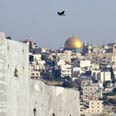
Security wall in Jerusalem
צילום: רויטרס
Prison fence
Jerusalem-area fence will imprison Palestinians, block peace
More than anything, the obstacle course currently being built around Jerusalem expresses Prime Minister Sharon's policy: It is an attempt to establish permanent borders for the State of Israel by pushing settlement activity under the guise of security, using the pretext that there is no Palestinian partner to conduct a meaningful political dialogue with.
The result of this policy could be tragic: Without a Palestinian capital in eastern Jerusalem – an absolute requirement to bring the conflict to an end and resolve all outstanding claims – there will be no possibility of reaching an agreement in future. As such, this policy will ensure ongoing violence and conflict.
The "Seam" line, approved by the government on October 1, 2003, sketched out in practice the borders of the Jerusalem corridor the government hoped to establish.
In the north, the government asked to include the future route of Route 45, slated to run from north Jerusalem to the center of the country, inside the fence. In order to accomplish this, it suggested building a "deep" fence , some three-to-four kilometers (1.8 – 2.4 miles) north of Route 443 (when asked what purpose the fence would serve, the government said it was intended to protect the road form light-weapons fire).
According to government estimates, some of the 90,000 Palestinians, who remain jailed in 14 villages between the main fence and the deep fence and have been separated from most of their lands, will ask their future in another way, in a way similar to that taken by jailed residents of Qalqilya – and the Palestinians left over will be annexed to Israel.
In the south, the fence will pass south of Gush Etzion and east of Route 60, the main road leading to the area, and south of the settlement of Efrat, proposing a similar prison experience for 17,000 Palestinians in five villages in the near future.
Changes, but no change
In June, 2004, the Supreme Court, accepting international involvement, ruled the government had to change the route significantly from its original plan, but the changes ratified by the government in February, 2005 include 67 square kilometers (about 26 sq. miles) between Jerusalem and Ma'aleh Adumim and east of Ma'aleh Adumim to complete what it calls "metropolitan Jerusalem" and is intended to prevent Jerusalem from becoming a "border town."
This plan, prepared with in coordination with the Jerusalem municipality, aims to justify Israel's claim of annexation in a permanent-status agreement. This will be realized in two ways:
1. Geographically – by cutting off Palestinian East Jerusalem from the West Bank, it cannot serve as an unofficial capital.
2. Demographically – by building a "Jewish urban belt" around the Palestinian East Jerusalem – by means of 1,200 housing units in Geva Binyamin in the north, 3,500 planned units in the E-1 corridor in the center, 200 in the "Kedmat Zion" neighborhood of Abu Dis, 350 in the "Nof Zion" section of Jabal Muchaber, Har Homa and 13,600 in "Nof Yael", near the village of Wallaje.
Ring road, tunnel, to link Arab cities
The transport solutions offered by Israel – Route 80, an "eastern ring road" and a tunnel – could ensure, within a decade, Palestinian travel between Bethlehem and Ramallah, but won't maintain East Jerusalem's place as a political, economic, social or religious Palestinian center in the West Bank.
This policy will bring about the opposite results of those intended, because thousands of Palestinians, from villages outside the fence, hold Israeli ID cards, will make their way back to the city and join the 200,000 Palestinian residents left there.
This phenomenon will strengthen the trend by which Palestinians have significantly raised their demographic representation in Jerusalem, from 22 percent in 1967 to more than a third today.
This tendency also threatens Jerusalem's ability to function, because Palestinian residents boycott local elections and run their own education, health, transport, business and cultural systems, almost completely separately from the city's Jewish population.
Other options
Against the government's plan, the "Council for Security and Freedom" presents another option to security problems: We should route the fence to separate populations (between Jewish and Palestinian neighborhoods) without adding additional areas from the West Bank.
This alternate plan stresses demographic separation and will ensure the security of Israelis in both eastern and western halves of the city. In doing so, this plan will preserve the possibility to return to negotiations on the basis of President Clinton's proposals in December, 2000.
In keeping with President Bush and the American government's objection to the eastern fence in Jerusalem and expanded Jewish building in the eastern part of the city, Israeli government ministers would be wise to accept a new definition of the borders of Israeli Jerusalem, for indeed the attempt to include Palestinian al-Quds will imprison not just a quarter-million Palestinian residents, but mainly it will thwart all chance to reach a permanent-status agreement and regional stability.
Brig. Gen. (res.) Shaul Arieli is a member of the Council for Peace and Security and helped formulate the Geneva Initiative










